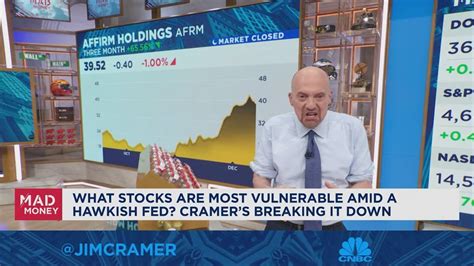
As economic uncertainties loom, CNBC’s Jim Cramer is advising investors to fortify their portfolios with two asset classes he believes are resistant to debt pressures: gold and select, high-performing companies. He specifically highlights companies demonstrating substantial revenue growth and robust balance sheets as potential safe havens during economic downturns.
Amidst growing concerns about rising interest rates and their potential impact on corporate earnings and the broader economy, Cramer suggests that investors seek refuge in assets that tend to hold their value or even appreciate during periods of financial stress. Gold, traditionally viewed as a safe-haven asset, and companies with strong financial fundamentals, represent his recommended strategy for weathering potential economic storms.
“I always say there is always a bull market somewhere, and I think right now, the bull market is in balance sheets,” Cramer said on a recent episode of CNBC’s “Mad Money.” His emphasis on strong balance sheets underscores the importance of selecting companies that are well-positioned to navigate economic headwinds.
Cramer’s call to action comes as investors grapple with the Federal Reserve’s ongoing efforts to combat inflation through interest rate hikes. While these measures aim to cool down the economy and bring inflation under control, they also raise concerns about a potential recession and the impact on corporate profitability. In this environment, Cramer believes that a defensive investment strategy is warranted.
The Case for Gold
Gold has long been considered a store of value and a hedge against inflation and economic uncertainty. Unlike stocks and bonds, gold is not tied to any specific company or government, making it less susceptible to the risks associated with these assets.
During times of economic turmoil, investors often flock to gold as a safe haven, driving up its price. This phenomenon was evident during the 2008 financial crisis and the COVID-19 pandemic, when gold prices surged as investors sought refuge from market volatility.
Cramer has been a long-time advocate for including gold in a diversified investment portfolio. He believes that gold can provide a cushion during economic downturns and help to preserve capital. However, he cautions that gold is not a guaranteed investment and that its price can fluctuate.
“I’ve always liked gold, and I think it’s a good idea to have some in your portfolio,” Cramer said. “It’s a hedge against uncertainty, and it can help to protect you when things get tough.”
Identifying “Debt-Proof” Companies
In addition to gold, Cramer recommends investing in companies with strong balance sheets and proven track records of revenue growth. These companies are better positioned to withstand economic headwinds and continue to generate profits, even during challenging times.
Cramer emphasizes the importance of analyzing a company’s financial statements to assess its financial health. He looks for companies with low debt levels, strong cash flow, and consistent earnings growth. These indicators suggest that a company is well-managed and financially stable.
He also highlights the importance of revenue growth as a key indicator of a company’s future prospects. Companies that are able to consistently grow their revenue are more likely to generate profits and reward their shareholders over the long term.
Cramer did not specifically name individual companies that he considers to be “debt-proof” in the referenced article. However, he often discusses companies on his show that meet his criteria for strong financial performance and growth potential. Investors can research companies in sectors that are generally considered to be defensive, such as consumer staples, healthcare, and utilities, and analyze their financial statements to identify potential candidates.
Navigating the Current Economic Landscape
The current economic environment is characterized by high inflation, rising interest rates, and geopolitical uncertainty. These factors have created a challenging environment for investors, and many are unsure how to navigate the market.
Cramer’s advice to invest in gold and companies with strong balance sheets is a defensive strategy that aims to protect capital during economic downturns. While this strategy may not generate the same level of returns as more aggressive investment approaches, it can help to mitigate risk and preserve wealth.
Investors should carefully consider their own risk tolerance and investment goals before making any decisions. It is also important to consult with a financial advisor to develop a personalized investment strategy that is tailored to their individual needs.
Potential Downsides and Considerations
While Cramer’s strategy offers a potential safe harbor, it’s crucial to acknowledge potential drawbacks:
- Opportunity Cost: Investing in gold and defensive stocks might lead to missing out on higher returns from growth stocks during periods of economic expansion.
- Gold’s Volatility: Although considered a safe haven, gold prices can still fluctuate significantly in the short term due to market sentiment and speculative trading.
- Company-Specific Risks: Even companies with strong balance sheets can face unexpected challenges, such as regulatory changes, technological disruptions, or shifts in consumer preferences.
- Inflation Erosion: While gold is often touted as an inflation hedge, its returns might not always outpace inflation, especially in the short term.
- Market Timing: Accurately predicting economic downturns is difficult, and investors who prematurely shift to defensive assets might underperform the market if the expected downturn doesn’t materialize or is milder than anticipated.
Diversification Remains Key
Even with Cramer’s recommendations, a diversified portfolio is essential. Diversification involves spreading investments across various asset classes, sectors, and geographic regions to reduce overall risk.
A well-diversified portfolio might include a mix of stocks, bonds, real estate, and commodities, in addition to gold and defensive stocks. The specific allocation will depend on an investor’s risk tolerance, time horizon, and financial goals.
Expert Opinions and Alternative Strategies
While Cramer’s views are widely followed, it’s important to consider other expert opinions and alternative investment strategies. Some financial advisors recommend focusing on long-term growth stocks, even during economic uncertainty, arguing that these companies have the potential to generate significant returns over the long run.
Others advocate for a more balanced approach, combining defensive assets with growth stocks and actively managing the portfolio to adjust to changing market conditions.
Conclusion
Jim Cramer’s recommendation to invest in gold and companies with strong balance sheets reflects a cautious approach to navigating the current economic landscape. While this strategy may offer a degree of protection during economic downturns, it’s important to consider potential drawbacks and maintain a diversified portfolio. Investors should carefully assess their own risk tolerance and investment goals before making any decisions and consult with a financial advisor to develop a personalized investment strategy.
FAQ Section:
1. Why is Jim Cramer recommending gold and “debt-proof” companies now?
Jim Cramer is recommending these assets due to increasing economic uncertainty, rising interest rates, and concerns about a potential recession. He believes gold and companies with strong balance sheets are better positioned to withstand economic headwinds and preserve capital during turbulent times. The quote “I always say there is always a bull market somewhere, and I think right now, the bull market is in balance sheets” reflects his emphasis on financial strength in the current market.
2. How does gold act as a “safe haven” asset?
Gold is considered a safe haven because it tends to maintain or increase its value during economic downturns and periods of high inflation. Unlike stocks and bonds, gold is not tied to any specific company or government, making it less susceptible to the risks associated with these assets. Investors often flock to gold during times of uncertainty, driving up its price.
3. What criteria should investors use to identify “debt-proof” companies?
Investors should look for companies with low debt levels, strong cash flow, and consistent earnings growth. These indicators suggest that a company is well-managed and financially stable. Revenue growth is also a key indicator of a company’s future prospects. Although Cramer didn’t provide specific company names, he advocates for analyzing a company’s financial statements to assess its financial health.
4. What are the potential downsides of investing solely in gold and “debt-proof” companies?
Potential downsides include the opportunity cost of missing out on higher returns from growth stocks during economic expansions, gold’s price volatility, and the possibility of company-specific risks even for financially strong companies. Additionally, gold’s returns might not always outpace inflation in the short term.
5. How does diversification fit into this investment strategy?
Diversification remains crucial even with Cramer’s recommendations. A well-diversified portfolio should include a mix of stocks, bonds, real estate, and commodities, in addition to gold and defensive stocks. The specific allocation will depend on an investor’s risk tolerance, time horizon, and financial goals. Diversification helps to reduce overall risk by spreading investments across various asset classes, sectors, and geographic regions.
Expanded Article: The Nuances of Cramer’s “Debt-Proof” Portfolio Strategy
Jim Cramer’s recent advice to shield portfolios with gold and “debt-proof” companies resonates with investors grappling with a complex economic landscape. However, a deeper examination reveals the nuances and potential pitfalls of this strategy, demanding a more comprehensive understanding for effective implementation. This expanded analysis delves into the intricacies of Cramer’s recommendations, exploring alternative perspectives and offering a balanced view for informed decision-making.
Beyond the Headlines: Understanding Cramer’s Rationale
Cramer’s recommendation isn’t simply about blindly investing in gold and specific companies; it’s rooted in a broader assessment of the current economic climate. The Federal Reserve’s aggressive interest rate hikes, aimed at curbing inflation, have cast a shadow over corporate earnings and economic growth. Higher interest rates translate to increased borrowing costs for companies, potentially impacting their profitability and investment plans. This concern, coupled with geopolitical uncertainties, fuels a risk-averse sentiment among investors.
In this context, Cramer’s emphasis on gold and financially sound companies reflects a desire for stability and capital preservation. Gold, with its historical role as a safe haven, offers a potential buffer against market volatility. Companies with robust balance sheets and consistent revenue growth are perceived as more resilient to economic downturns, capable of weathering storms that might sink weaker competitors.
The Allure and Limitations of Gold
Gold’s appeal as a safe haven stems from its intrinsic value and its perceived independence from the vagaries of the financial system. Unlike fiat currencies, which are subject to government control and inflation, gold’s supply is relatively limited, contributing to its value retention over long periods. During economic crises, when confidence in stocks and bonds erodes, investors often turn to gold, driving up its price.
However, gold is not a foolproof investment. Its price can be volatile in the short term, influenced by factors such as interest rates, currency fluctuations, and investor sentiment. While gold is often touted as an inflation hedge, its performance in this regard can be inconsistent. In some periods, gold has outpaced inflation, while in others, it has lagged behind.
Moreover, gold doesn’t generate income like stocks or bonds. Its value lies solely in its price appreciation, making it a less attractive investment during periods of economic expansion when other asset classes offer higher returns. Holding a significant portion of a portfolio in gold can therefore lead to opportunity costs.
Deconstructing “Debt-Proof” Companies: A Deeper Dive
Identifying truly “debt-proof” companies requires a rigorous analysis of their financial statements and business models. Cramer’s emphasis on strong balance sheets, low debt levels, and consistent revenue growth provides a solid starting point. However, investors need to delve deeper to assess the sustainability of these factors.
Key metrics to consider include:
- Debt-to-Equity Ratio: This ratio measures a company’s debt relative to its equity. A lower ratio indicates a more conservative financial structure and a greater ability to manage debt obligations.
- Interest Coverage Ratio: This ratio measures a company’s ability to pay its interest expenses. A higher ratio indicates a stronger ability to service debt.
- Free Cash Flow: This metric represents the cash a company generates after accounting for capital expenditures. Strong free cash flow provides flexibility for investments, debt repayment, and shareholder returns.
- Revenue Growth Rate: Consistent revenue growth demonstrates a company’s ability to expand its market share and generate profits. However, it’s important to assess the quality of revenue growth, ensuring it’s sustainable and not driven by unsustainable pricing strategies or one-off events.
- Profit Margins: High profit margins indicate a company’s efficiency and pricing power. Companies with strong profit margins are better positioned to withstand cost pressures and maintain profitability during economic downturns.
Beyond financial metrics, it’s crucial to assess a company’s competitive landscape, industry dynamics, and management quality. A company operating in a resilient industry with a strong competitive advantage and capable management is more likely to weather economic storms.
Alternative Perspectives: Challenging the Conventional Wisdom
While Cramer’s strategy offers a defensive approach, it’s important to consider alternative perspectives and investment strategies. Some financial advisors argue that focusing on long-term growth stocks, even during economic uncertainty, can generate superior returns over the long run. These advisors believe that companies with innovative products, disruptive technologies, and strong growth potential are capable of outperforming the market, regardless of short-term economic fluctuations.
Another approach involves actively managing the portfolio, adjusting asset allocations based on changing market conditions. This strategy requires a more hands-on approach, but it allows investors to capitalize on opportunities and mitigate risks as they arise. For example, an active manager might reduce exposure to cyclical sectors during economic downturns and increase exposure to defensive sectors.
The Importance of Diversification and Asset Allocation
Regardless of the specific investment strategy, diversification remains a cornerstone of sound portfolio management. Diversifying across asset classes, sectors, and geographic regions helps to reduce overall risk and improve long-term returns.
A well-diversified portfolio might include a mix of:
- Stocks: Representing ownership in companies, stocks offer the potential for high returns but also carry higher risk.
- Bonds: Representing debt instruments, bonds provide income and tend to be less volatile than stocks.
- Real Estate: Providing diversification and potential income through rent, real estate can be a valuable component of a portfolio.
- Commodities: Including gold, oil, and agricultural products, commodities can offer inflation protection and diversification benefits.
The specific allocation to each asset class should be tailored to an investor’s risk tolerance, time horizon, and financial goals. Younger investors with longer time horizons might allocate a larger portion of their portfolio to stocks, while older investors nearing retirement might favor bonds and other less volatile assets.
Beyond Financial Considerations: Understanding Personal Risk Tolerance
Investing is not solely about numbers and financial metrics; it’s also about understanding personal risk tolerance. Risk tolerance refers to an investor’s ability and willingness to withstand potential losses in exchange for the possibility of higher returns.
Investors with high risk tolerance are comfortable with market volatility and are willing to accept larger losses in pursuit of higher gains. These investors might allocate a larger portion of their portfolio to stocks and other riskier assets.
Investors with low risk tolerance are more concerned about preserving capital and are less willing to accept potential losses. These investors might allocate a larger portion of their portfolio to bonds and other less volatile assets.
Understanding personal risk tolerance is crucial for making informed investment decisions and avoiding emotional reactions during market downturns.
The Role of a Financial Advisor
Navigating the complexities of the financial markets can be challenging, especially for novice investors. A financial advisor can provide valuable guidance and support in developing and implementing a personalized investment strategy.
A financial advisor can help investors:
- Assess their risk tolerance and financial goals.
- Develop a diversified portfolio that aligns with their individual needs.
- Monitor their portfolio and make adjustments as needed.
- Provide objective advice and support during market fluctuations.
Choosing a qualified and trustworthy financial advisor is essential. Investors should look for advisors who are fee-only, meaning they are compensated solely by their clients and not by commissions from selling financial products.
Conclusion: A Balanced Approach to Portfolio Protection
Jim Cramer’s advice to shield portfolios with gold and “debt-proof” companies provides a valuable starting point for investors concerned about economic uncertainty. However, a more nuanced understanding of the strategy’s potential benefits and limitations is crucial for effective implementation.
A balanced approach involves:
- Thoroughly analyzing potential investments, focusing on both financial metrics and qualitative factors.
- Considering alternative investment strategies and perspectives.
- Maintaining a diversified portfolio that aligns with individual risk tolerance and financial goals.
- Seeking guidance from a qualified financial advisor.
By adopting a comprehensive and informed approach, investors can navigate the complexities of the financial markets and build portfolios that are resilient to economic challenges and capable of achieving long-term financial success.
Further Considerations and Potential Investment Vehicles:
Expanding on Cramer’s core recommendations, several additional factors and investment vehicles merit consideration when constructing a “debt-proof” portfolio.
1. Inflation-Protected Securities (TIPS): Beyond gold, TIPS are U.S. Treasury bonds indexed to inflation. Their principal increases with inflation (as measured by the Consumer Price Index), helping to preserve purchasing power. While not offering explosive growth, they provide a stable, government-backed hedge against rising prices.
2. Value Investing Approach: Instead of simply seeking companies with low debt, embrace a value investing philosophy. This involves identifying undervalued companies – those trading below their intrinsic value – regardless of their current debt levels. A skilled value investor can find opportunities in companies that are temporarily out of favor but possess strong underlying fundamentals and the potential for future growth. Researching companies using principles outlined by investors like Benjamin Graham or Warren Buffet can be beneficial.
3. Real Estate Investment Trusts (REITs): Specifically, consider REITs focused on essential infrastructure, such as data centers or cell towers. These assets provide critical services, generating consistent revenue streams even during economic downturns. Carefully analyze the REIT’s management, occupancy rates, and debt levels before investing.
4. Dividend-Paying Stocks: Companies with a long history of consistently paying and increasing dividends can provide a steady income stream during volatile market conditions. Focus on companies in mature, stable industries, such as consumer staples or utilities, that have a track record of generating consistent cash flow. Review the company’s dividend payout ratio (the percentage of earnings paid out as dividends) to ensure the dividend is sustainable.
5. Short-Term Bonds and Cash Equivalents: Holding a portion of your portfolio in short-term bonds or cash equivalents provides liquidity and flexibility. This allows you to take advantage of investment opportunities that may arise during market downturns or to cover unexpected expenses.
6. Actively Managed Funds: While index funds offer diversification, consider actively managed funds with experienced managers who can navigate volatile markets and identify undervalued opportunities. Look for funds with a consistent track record of outperforming their benchmark index and a low expense ratio. However, remember that past performance is not indicative of future results.
7. Private Equity and Alternative Investments: For sophisticated investors, consider allocating a small portion of their portfolio to private equity or other alternative investments, such as hedge funds or real estate. These investments can offer diversification benefits and the potential for higher returns, but they also come with higher risks and illiquidity.
8. Sector Rotation Strategy: Be prepared to rotate your portfolio among different sectors of the economy as market conditions change. During economic downturns, focus on defensive sectors, such as healthcare, consumer staples, and utilities. As the economy recovers, shift your investments towards cyclical sectors, such as technology, industrials, and financials.
9. Tax-Loss Harvesting: Use tax-loss harvesting to offset capital gains and reduce your tax liability. This involves selling losing investments to generate capital losses, which can then be used to offset capital gains from winning investments.
10. Long-Term Perspective: Most importantly, maintain a long-term perspective and avoid making impulsive decisions based on short-term market fluctuations. Remember that investing is a marathon, not a sprint. Stick to your investment plan and resist the temptation to panic sell during market downturns.
By incorporating these additional considerations and exploring a wider range of investment vehicles, investors can construct a more robust and diversified “debt-proof” portfolio that is better equipped to withstand economic challenges and achieve long-term financial success. Remember to consult with a qualified financial advisor to develop a personalized investment strategy that is tailored to your individual needs and circumstances.









